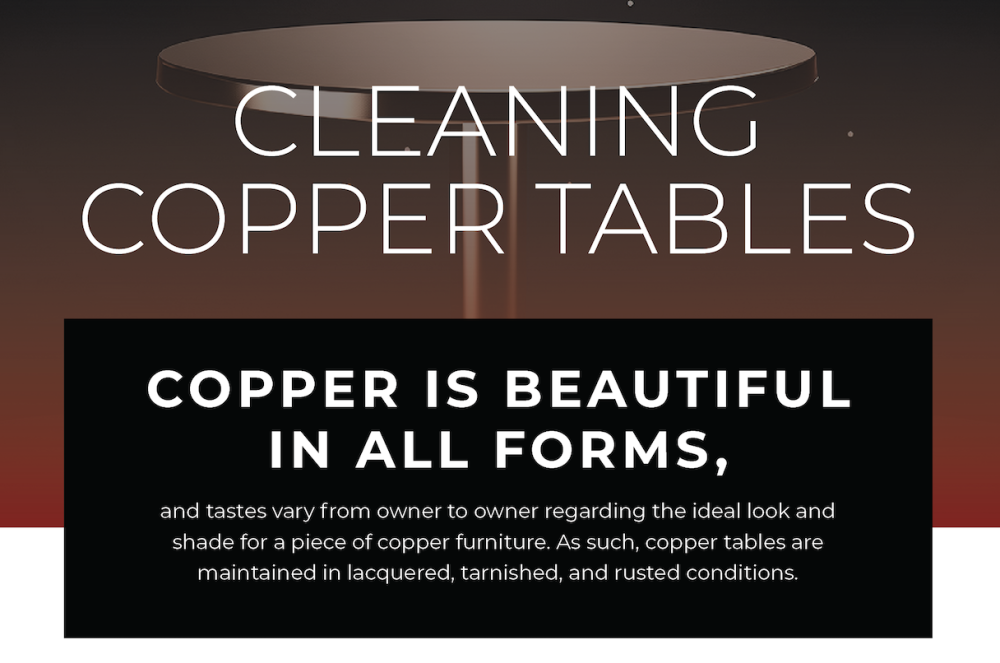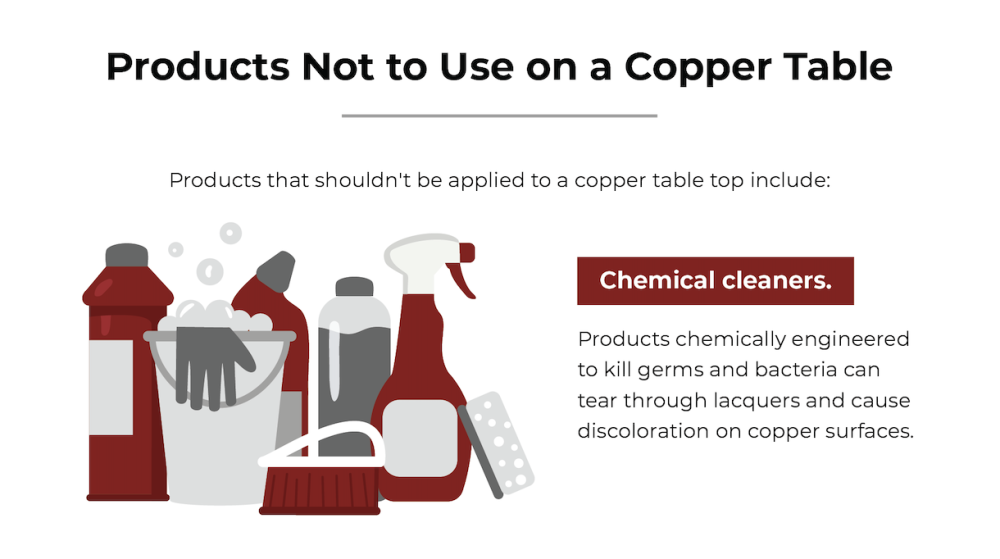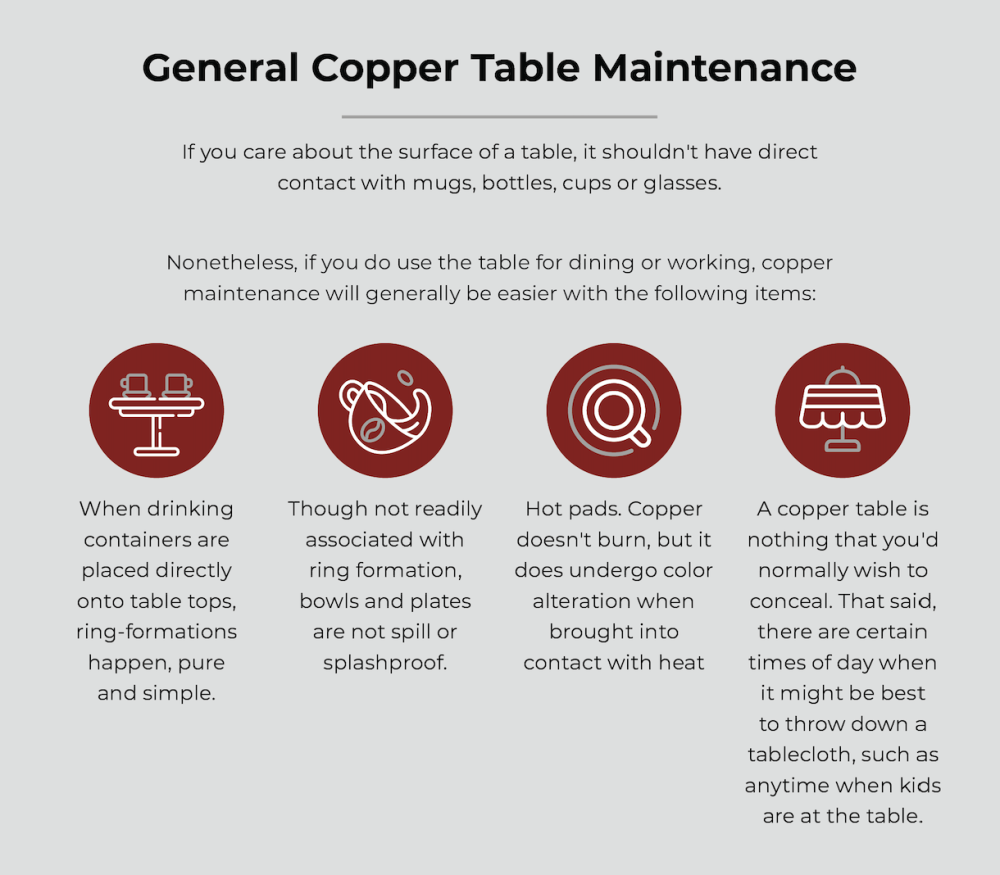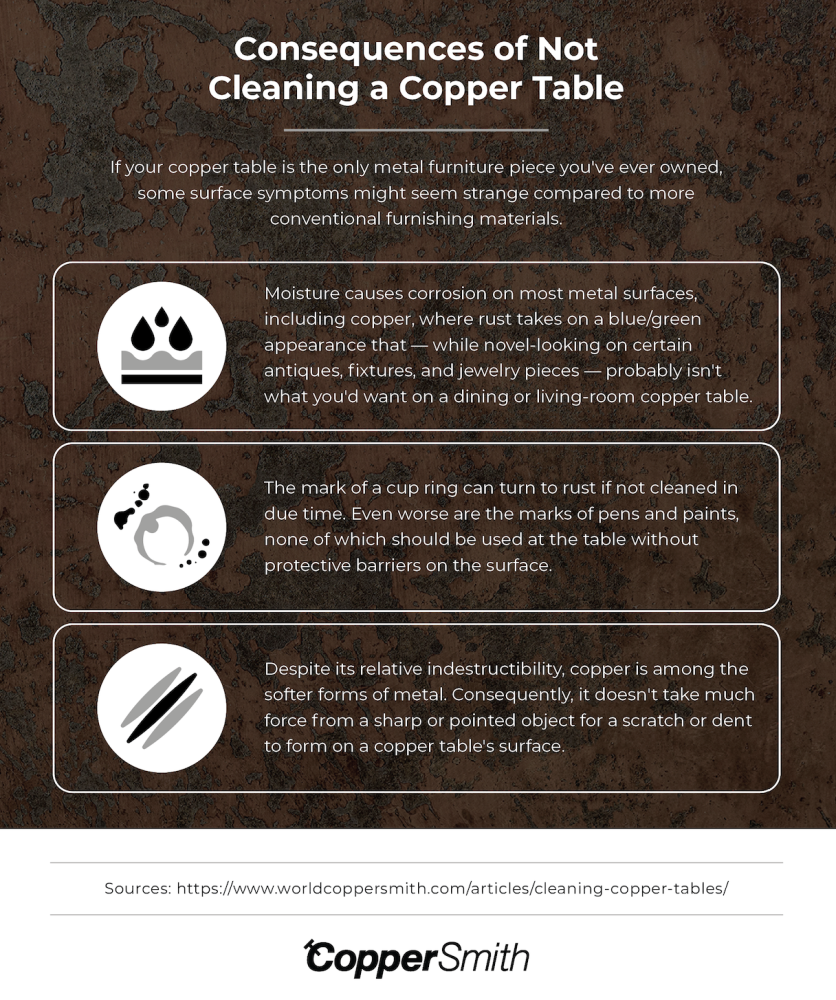
Copper is beautiful in all of its forms, and tastes vary from owner to owner regarding the ideal look and shade for a piece of copper furniture. As such, copper tables are maintained in lacquered, tarnished and even rusted conditions. However, when it comes to copper tables for the living room or dining area, like our Serria hammered copper kitchen table, chances are you'd want the surface to maintain either a rust-free, darkened-with-age tone or the original copper-red color the table had when first assembled. Whichever your preference, copper countertop maintenance is an essential part of preservation for tables and other furnishings made of this strong yet sensitive metal.
Three Steps to a Clean Copper Table
When people first ask about how to clean copper table tops, they typically assume that it's a complicated process that involves special products. Fact is, copper maintenance is easy to fulfill at regular intervals on a table of any size, and the process doesn't involve any special tools or strong chemicals.
In order to maintain a clean and stain-free surface to your copper table, apply the following regimen on a consistent basis:

- Dust regularly. First and foremost, a copper table should be dusted at least twice each week with a soft cloth. As one of the shiniest of table surfaces, copper needs its clarity — even minor specs of dust can be easy to spot with the naked eye. Since dust typically spreads from overhanging fixtures and adjacent surfaces, it's also important to keep the surrounding area dusted on a regular basis in order to slow the frequency of buildup on your copper table.
- Clean fortnightly. Despite the metal's overall strength, it doesn't take long for copper surfaces to show traces of exposure to the elements. Therefore, a copper table should be cleaned at least twice each month with light, sensitive cleaning equipment. No chemicals are needed. Natural, everyday cleaning supplies — as detailed in the next section — work best. Basically, if it's good for your hands, it's good for your copper table.
- Wax after every clean. If the table isn't lacquered, but you still wish to preserve the copper's shiny, golden-brown surface, apply wax to the table after every cleaning. If the table has already tarnished, but you would like to restore the copper to a fresher appearance, read on to learn how to clean tarnished copper tables in the next section.
Basically, the only steps needed to maintain clean copper tables are quick twice-weekly dustings, twice-monthly cleanings and periodic waxings.
Essential Materials for Copper Table Maintenance
 Clean copper tables rely on a few basic products that you probably already have in your cabinet of cleaning supplies. Due to copper's sensitive nature, however, the application of said products requires a bit more sensitivity than would typically be applied with other housecleaning tasks. If the following actions are taken consistently and the table is generally used with care, the copper should remain beautiful for as long as it remains in your possession.
Clean copper tables rely on a few basic products that you probably already have in your cabinet of cleaning supplies. Due to copper's sensitive nature, however, the application of said products requires a bit more sensitivity than would typically be applied with other housecleaning tasks. If the following actions are taken consistently and the table is generally used with care, the copper should remain beautiful for as long as it remains in your possession.
A special note must be made about tarnish: On non-lacquered copper table tops, surfaces turn dark and somewhat spotty over the course of time. Nothing makes this contrast more obvious than pennies. Newer ones are shiny copper-red, while the centers of older ones are dark and matted. If you're looking to clean copper tarnish, you don't need to buy any special chemicals, since it can easily be accomplished with a few common kitchen products.
- For dust removal, all you need is a delicate, lint–free cloth. Alternately, a microfiber duster can do the trick. Wipe the cloth or duster across the table a few times, and the copper surface should be clear of all specs.
- The materials needed for cleaning are the same ones you probably use for your porcelain and china. Take a soft cloth, dampen it with warm water and lather it slightly with mild soap. Run the cloth across the surface of the table two or three times. With the table now clean, wipe it dry with a fresh cloth.
- De-tarnishing. If you purchased a non-lacquered copper table, and the surface has long since aged, the metal's light-brown freshness can still be restored with the application of one bottle of vinegar and three tablespoons of salt. Mix the two ingredients into a spray bottle and apply across the table top. Allow the solution to sit for two minutes, then wipe the surface dry with a fresh cloth. If you don't like the smell of vinegar, de-tarnishing can also be achieved with a mix of salt and lemon wedges.
- In some cases, a simple clean won't cut through the buildups of dirt and gunk on a copper table. If the surface of your table shows traces of caked-on dirt — despite being treated to a warm, soapy washcloth — apply light pressure over the stubborn spots with a non-abrasive scrubbing pad, then clean and dry the surface again. Alternately, encrusted gunk can be removed from copper tabletops with the use of a soft-bristle cleaning brush.
- On non-lacquered copper table tops, wax should be applied after every cleaning if you wish to preserve a shiny, copper-red tone across the table surface. Any commercial paste wax is suitable — simply spread the wax across the surface in circular motions with a soft sponge. Allow the wax to sit for at least 10 minutes. If you have a lacquered copper table, it's still wise to wax the surface at least twice each year — preferably after stain removal — to help maintain the outer coating.
- Once the wax has had time to sit and work its magic, buffer the surface dry with a fresh, soft cloth. With one or two circular motions over each square inch, the table top shine should come alive in all of its copper-red glory. Voila, you now have a newly cleaned and shined copper table.
On the whole, maintenance consists of dusting and cleaning for naturally dark copper tables; dusting, cleaning and finishing for shiny copper-red tables; plus de-tarnishing on any darker table that you wish to restore to copper-red.
Products Not to Use on a Copper Table

Copper is full of contradictions. On one hand, it's a strong metal that's infinitely reusable. At its surface, however, lies a delicate mineral makeup that easily reacts to various chemicals. As such, copper maintenance is best achieved with soft products that are simply meant to clean and shine but not strip away layers or kill germs on contact.
Products that shouldn't be applied to a copper table top include:
- Chemical cleaners. Strong chemicals can eat away at finishes and cause negative reactions on surfaces made of copper. Simply put, if it's bad for your hands, it's not good for the copper. Products to avoid when cleaning a copper table include bleach, ammonia, rubbing alcohol and baking soda. Ditto for commercial sink and bathtub cleaners, or anything manufactured for wood, tile or window cleaning.
- Products that are chemically engineered to kill germs and bacteria can tear through lacquers and cause discoloration on copper surfaces. Basically, if the application of a product requires ventilation or the aid of rubber gloves, it probably isn't right for anything made of copper.
- As a general rule of thumb, any cleaning product with a memorable TV mascot — whether it's a smiling bald man, a flexed arm holding a hammer or a bristle-bottomed bubble with eyes — is probably ill-suited for your copper table.
General Copper Table Maintenance

Like wood, like copper: If you care about the surface of a table, it shouldn't have direct contact with mugs, bottles, cups or glasses. For similar reasons, you wouldn't want soup droplets or food particles — particularly damp ones — to land straight on the copper.
Nonetheless, if you do use the table for dining or working, copper maintenance will generally be easier with the following items:
- When drinking containers are placed directly onto table tops, ring-formations happen, pure and simple. Coasters come in a range of materials and styles, and endless varieties are available in everything from wood and cork to fabric and plastic. Whatever style you choose, by all means place coasters under every cup, glass or mug on your copper table.
- Though not readily associated with ring formation, bowls and plates are by no means spill or splash proof. Likewise, dishes don't catch everything that falls. If your copper table is a place of dining, set placemats in front of each chair before every meal.
- Hot pads. Copper doesn't burn, but it does undergo color alteration when brought into contact with heat. Therefore, any pot, pan or tray that comes directly from the oven or stove should have a hot pad placed underneath whenever a freshly cooked entrée is served on the copper table.
- A copper table is nothing that you'd normally wish to conceal. That said, there are certain times of day when it might be best to throw down a tablecloth, such as anytime when kids are at the table. If you head an adults-only household, the usefulness of a tablecloth is your call. In any case, the more protective measures that are taken when dining on a copper table, the better.
A copper table should not be used as a cutting board, be it for bread or paper. When using forks, knives or other sharp utensils at the table, be sure to have dishes and placements on the table top to avoid scraping and nicking the copper's surface.
Consequences of Not Cleaning a Copper Table

If your copper table is the only metal furniture piece you've ever owned, some of the surface symptoms might seem strange when compared to more conventional furnishing materials. Glass, for example, never changes color. Wood, meanwhile, isn't subject to rust, and any color change is generally due to a dulling process that occurs much slower than with copper, which is exceedingly vulnerable to the following imperfections:
- Moisture causes corrosion on most metal surfaces, including copper, where rust takes on a blue/green appearance that — while novel-looking on certain antiques, fixtures and jewelry pieces — probably isn't what you'd want on a dining or living-room copper table. Therefore, moisture should be wiped from the table whenever it appears, whether it's due to temperatures or kitchen activity. Rust can also form when water drops or spills are left to evaporate on the copper's surface. Basically, nothing wet should ever touch the table top, unless it's a soapy wash cloth.
- The mark of a cup ring can turn to rust if not cleaned in due time. Even worse are the marks of pens and paints, none of which should be used at the table without protective barriers on the surface.
- Despite its relative indestructibility, copper is among the softer forms of metal. Consequently, it doesn't take much force from a sharp or pointed object for a scratch or dent to form on a copper table's surface.
Granted, copper is a resilient metal with an ability to self-heal over time. Marks, for instance, are gradually lost as the surface darkens on non-lacquered copper furnishings. Therefore, the consequences of neglect are most serious if you wish to maintain a shinier copper-red brightness across the table top.
Benefits of Having a Copper Table

As an attractive and much-valued natural material, copper is one of the finest choices for fixtures and home furnishings. Like all fine metals, copper conjures images of elegance and prestige in virtually any type of setting. As a material that has been around for eons, copper never goes out of style. With its neutral yet lustrous appearance, copper captures the eye and complements all of its surroundings. As one of the easiest materials to break down and remold, copper never ends up in landfills.
The following benefits are just a few of the many reasons to buy a copper table, as well as fixtures and furnishings made of the material:
- A copper table could be one of your most valuable home furnishings. You don't necessarily have to live in a mansion, but copper furnishings can make your home look like a haven of wealth to friends, neighbors and guests.
- Whether you use it for functional purposes or simply as a visual fixture, a copper table adds class and elegance to any room. Copper is both an attractive material and one that's largely associated with high-class interior.
- As with all natural resources, copper has a timeless quality that lasts through the ages, regardless of changing styles in furnishings and interiors. Therefore, you could have a modern-day interior or something that harkens back to the Old West or ancient China, and your copper table would fit right in with the overall scheme.
- Focal point. With its attractive color and shiny luster, copper is a magnet for the eyes. As such, copper furnishings are an attention-getter in any setting. Of all the items in your living room or dining area, a copper table could be the one that most often draws the eyes of family and guests.
- Copper goes with pretty much anything, whether you favor a classic interior or something futuristic and Space Age. Like all shiny metals, the look of copper is complementary to black and white designs, as well as earth tones, hues and primary/secondary schemes.
- Recyclable/indestructible. While not the most abundant of earth's resources, copper is among the most indestructible of elements, and therefore one of the most reused throughout the world. As such, copper is one of the eco-friendlier choices in furnishings.
With a copper table in your living or dining area, it could serve as a standout fixture that simultaneously manages to unify all the other elements in the room.
How to Accessorize a Copper Table

A copper table is not something you'd want buried under piles of papers, magazines, bills, stationery and other junk. Copper is meant to be seen, pure and simple. As a somewhat sensitive material, copper deserves care and attention when it forms the basis of a major household furniture item. Therefore, it's important to set the rules on what is and isn't allowed on a copper table.
Basically, copper tables are designed for special treatment because the material is an attraction in and of itself. But even though it isn't really appropriate to cover up a copper table, it can still be put to creative use with one or two none-too-intrusive accessories, such as the following:
- Fruit baskets. When it comes to table tops, few things are more inviting than fruit baskets. Whether you live alone or head a large household, a basket full of apples, pears, bananas or citrus fruits can be a fetching feature for children and guests. A fruit basket can also serve as a daily reminder to get your needed servings.
- The elegance of a vase is one of the most regal things that can grace a table top, whether you use it for flowers, branches or simply as a fixture in its own right. In terms of style, vases are also one of the more diverse table accouterments, since they come in wide, thin, oval, rectangular, ceramic, metal and glass varieties.
- For an element of sophistication, place a stack of two or three books on top of your copper table. Books are not only interesting to read or flip through, but they also add a touch of intellectualism to any room, which can be impressive to guests. If the book has an interesting title or cover, it can even serve as a visual fixture.
- Framed pictures. Wondering where to put some pictures? Instead of trying to cram them all onto your book shelves, countertops, cabinets and night stands, consider one or two special photos to place on your copper table.
- Ceramic fixtures. Table top fixtures don't need to be holders of some sort — they can also be visual props. If you like animals, consider a ceramic elephant or lion for your copper table. If you like antiques, find a piece of vintage eye candy from the 1920s, '30s or '40s. A copper table could even be the place to store those ubiquitous copper chips — as in pennies — in a ceramic piggy bank.
- Few household accessories are as relaxing and romantic as candles, which can be used for light, meditation or setting an evening mood. Of all the surfaces on which you could place candles, a copper table would be one of the safest, since copper — as a metal — is non–flammable.
Unlike the more utilitarian furnishings of a given household, a copper table is a unique attraction. However, for the one or two items that take permanent residence on top, the copper can serve as a visual mantle that helps draw attention to the flowers, candles or pictures.
Where to Look for Copper Table Tops

If you're looking for copper tables and table tops, CopperSmith carries a range of high-end, luxury styles in square and round, light and dark varieties. Whether you want something for your kitchen or dining area, we have copper tables that can complement any interior scheme. To learn more about our copper tables, table tops and other home furnishings, click on over to our product pages today.
How To Clean Your Copper Table Naturally
If you want to protect your copper table while keeping it clean, then the best way to do this is to use natural copper cleaners.
There are various natural copper cleaners that are fantastic for this including:
- Baking soda
- Lemon
- Salt and vinegar
Baking soda can be combined with a wide range of different natural ingredients to make the perfect natural cleaner for a copper table. This includes everything from lemon to ketchup.
Or, you can use lemon by cutting a lemon in half and adding a little salt into the inside. You can then rub the lemon across the surface of the table. It’s important to not use too much pressure here. Alternatively, you may want to use a paste mixing lemon juice with cornstarch. This is going to make your copper table look incredible once you’re finished.
To use salt and vinegar, add 1 tablespoon of salt combined with a tablespoon of vinegar onto a soft cloth. You can then wipe your copper table carefully before rinsing off the product. Remember, copper is resistant to water.
If you’re not sure, then you can always test options like this on a penny. Pennies are made of copper so you can dunk them in different natural ingredients to determine which one makes copper look more shiny and beautiful.
What Should You Do If You Scratch The Surface Of A Copper Table?
As mentioned, copper is quite a soft metal. As such, it’s easy to accidentally scratch the surface of a copper table. This could be caused by a piece of cutlery or even while cleaning the table with a cloth that is too rough. You should never use a scourer on a copper table for this reason, even when dealing with tough stains.
The good news is that you don’t need to panic if you scratch your copper table. Indeed, the best thing to do is to simply leave it alone. If you do this, then you will notice that the affected area regains its natural color overtime. Remember, copper is a living material and when it’s exposed to oxygen, it will return to its original color. This is the same reason why a copper penny will eventually turn brown. How long this takes can depend on a range of factors including the room environment. However, you should expect the natural color to return after just a few weeks.
Once the affected area has ‘healed,’ the original tone of the table will return. You can then seal the copper again with a wax, available from our store. This will allow you to protect the original finish of your furniture.
The scratch on your table is still going to be there. However, it won’t be visible because it will have returned to its natural color. As such, your copper table will once again look flawless.
Do All Copper Tables Provide The Same Benefits?
It’s important to be aware that all copper tables will not provide the countless benefits discussed above. Whether or not a copper table lasts or stands the test of time will depend on how it is manufactured. There are two factors that will determine the quality of a copper table:
- Gauge
- Purity
If a copper table is not produced to the right standards or does not have a high level of purity, then you are going to notice that it starts to show signs of wear and tear far more quickly. Furthermore, it may not provide the beautiful aesthetic that you wanted for your home.
This is why it’s important to make sure that you are purchasing a copper table from a trusted supplier. At CopperSmith, we have a fine selection of copper tabletops for you to choose from that could be perfect for your home. All of our copper tables are designed and manufactured to the highest standard of quality. As such, they will provide all the benefits listed above and be an incredible new addition to your home.
If you are purchasing a second-hand copper table or a copper table from another supplier, we recommend that you complete a thorough investigation. It’s important to make sure that you know exactly what you are purchasing. There are a range of steps that you can take to check if a copper table is authentic. This includes:
- Rubbing it with salt or vinegar to check if it turns green
- See if it sticks to a magnet - copper shouldn’t attract any type of magnet
- Check the shade of the cleaned table



